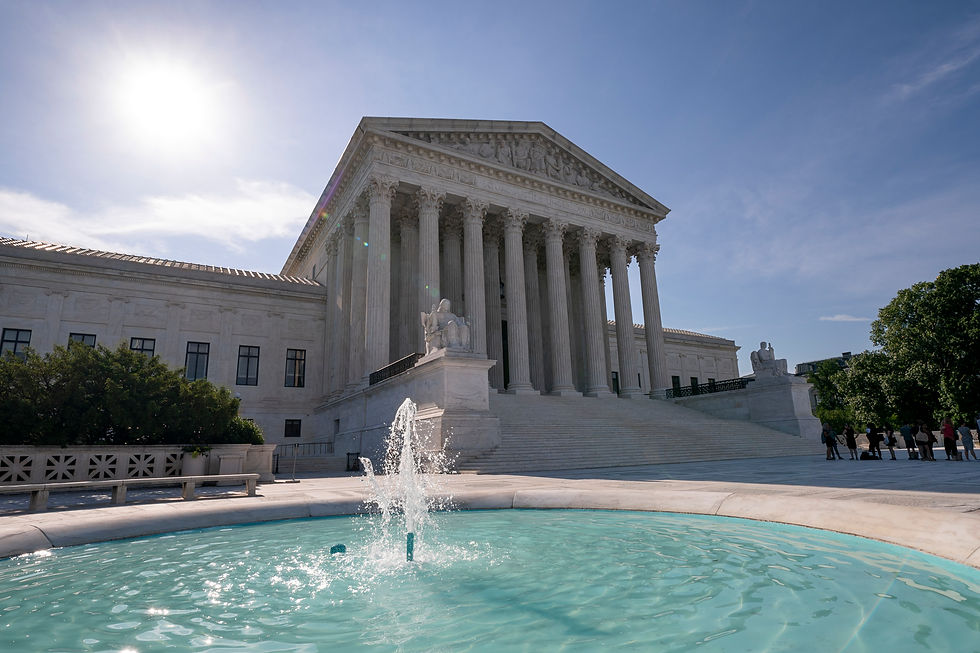The Supreme Court: For Dummies
- Cassidy White
- Jun 18, 2019
- 3 min read
Hello & welcome to my first blog post!
From reading the title of my post, you can tell this article is going to be about the Supreme Court. Let me start by saying I am in no means an “expert” when it comes to courts and laws. In fact, my knowledge is very limited.
My plan for this article is to give a list that simplifies the cycle of the life of a case when it reaches the Supreme Court. Then, I will backtrack and elaborate.
The 5 step cycle of a case:
1. Cases are sorted into piles of the same category.
2. Each week, the 9 Justices meet to decide which cases to accept.
3. When a case is chosen, both lawyers from opposing sides get 30 minutes to argue their point.
4. After a few days, the Justices vote & one is chosen to write an opinion.
5. In June, at the end of the term, the court releases all decisions made.
Now that you have the “dummy” version of the cycle of a case, I would like to elaborate. First things first… While the Supreme Court holds the most power, they can only respond to cases that the people (us) bring to their attention. This means that the court can’t choose to trial a topic if they haven’t received a case for. Only when the Supreme Court receives a case can they act upon it. The Supreme Court receives more than 1,000 cases a year and that breaks down into about 100 cases a week! Cases can range from murder to the President of the United States defending his or her power. Most of the cases received are petitions saying that a lower court ruling was in the wrong.
Fun fact: the court only accepts 100 cases a year.
Once a week, all 9 Chief Justices meet in a conference room to discuss the cases they have received. Using the voting method, cases are selected for trial. When a case goes to trial, the case is now in the hands of the public’s fate.
Each person (justice) is allowed their own opinion. The Justices might disagree, but they respect the others’ perspectives and thoughts. When a case is chosen, each Justice is assigned a group of law clerks and secretaries to help look over the facts. It is important to note that it is up to the Justice to make the final decision on the case.
During the oral argument, both lawyers have exactly 30 minutes to argue their case. During the oral argument, the lawyer answers questions that the Justices have. If the Justices are split on a case, the lawyer might end up juggling multiple sides/opinions. Each case is held publicly, as the jury holds a big say in the end. To sum this process up I will say this.. the court has a conversation with itself through the attorney’s representing each side of the case.
Within a few days of the court hearing, the Justices gather ALONE to vote on the case. Next, one justice from the majority vote is chosen to write an opinion. The opinion explains the legal reasoning behind the decision that was made. This is the most time-consuming part of their work. While only one Justice was chosen to write an opinion, Justices’ that are opposing the decision or that agree with it may express themselves in their own opinion. If the court is divided, opinions can be 80 pages or more in length!
The first draft, from the Justice that was assigned to write the opinion, is finished within four weeks and sent to the other Justices. Justice’s may choose to revise the opinion. At the end of the term in late June, the court releases all decisions made. A Public Relations Officer is notified via telephone of all decisions made. From there, the officer can release copies of opinions to the press (us journalists).
The unspoken contract between the Supreme Court and the people are the hidden key to freedom. Without this, the government would not give us freedom. The court’s power only exists as long as the American people trust and believe in the system. Without the people’s trust, the court loses all power.







Yorumlar